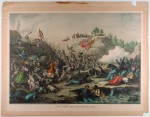 Kurz and Allison was a major publisher of chromolithographs in the late nineteenth century. They were based in Chicago, IL, and built their reputation on large prints of American Civil War battles. Kurz was himself a veteran of the Civil war, suggesting that many of the chosen depictions were especially significant to him.[i]
Kurz and Allison was a major publisher of chromolithographs in the late nineteenth century. They were based in Chicago, IL, and built their reputation on large prints of American Civil War battles. Kurz was himself a veteran of the Civil war, suggesting that many of the chosen depictions were especially significant to him.[i]
Although lithography was invented by Alois Senefelder in Germany in 1798, within twenty years it appeared in England and the United States.[ii] Chromolithography, lithography’s second-generation innovation, is a mid-nineteenth century invention for making multi-colored prints. It requires the use of heavy stones, in most cases limestone, which are colored or drawn on with greasy ink or crayons. The stone is then moistened with water and areas not covered by crayon become wet. An oily ink is then applied using a roller, and adheres only to the drawing while being repelled by the wet parts of the stone. Finally, the print is made by pressing paper against the inked drawing. The Fort Pillow Massacre was a very particular form of the chromolithograph that used several colors in the printing process, but was hand-colored after printing. Its development took several months considering the amount of detail in the print.[iii]
Kurz and Allison’s depiction of Confederate and Union soldiers, as well as black slaves, is an accurate account of the Fort Pillow Massacre. The Fort Pillow Massacre was one of the worst marks on the record of Confederate troops during the American Civil War. Fort Pillow was located on the Tennessee bank of the Mississippi River, and had fallen into Union hands in May 1862. However, even two years later, and with the main fighting now focused on the road to Atlanta, Confederate raiders still forced the Union to maintain garrisons across the occupied south. One of the best known of those raiders was Nathan Bedford Forrest. He had been commanding a cavalry in Tennessee, but after the Confederate victory at Chickamauga (19-20 September 1864), he had fallen out with General Bragg (as had so many others), and refused to serve under him any longer. While Bragg settled down to besiege Chattanooga, Forrest headed back to an independent command in Mississippi. In March 1864, Forrest took a division of cavalry (about 1,500 men), on a raid north through western Tennessee, that actually reached as far north as Paducah, Kentucky. It was on his way back south that Forrest and his men committed what is now generally accepted as a massacre.[iv] [v] [vi]
Seen in The Fort Pillow Massacre is that Confederate cavalry being led by, none other than, Nathan Forrest. The display of Confederate soldiers mercilessly slaughtering both Union soldiers and slaves represents the malevolent image of the South as arrogant barbarians. This mindless violence depicted in the chromolithograph signifies the amount of sorrow and pain that accompanies any fight, which in this case, is the struggle for racial equality. Here, unarmed men and women are being ruthlessly murdered by the blades of Confederate rifles in an attempt to further symbolize the maliciousness and brutality of the acts committed. Even rocks are used as weapons against black men, women, even children, no less, who fight for their lives or fear for them. Children appear in the chromolithograph, not only for historical accuracy, but also as a reminder that race struggle affects all forthcoming generations just as much as the generations fighting to end race struggle. The Fort Pillow Massacre truthfully illustrates the horrific event that was Fort Pillow, but also represents the struggle and pain of a generation that maintained the courage to fight for justice against a shadowy world of denial and discrimination.
Ultimately, The Fort Pillow Massacre symbolizes a struggle within a struggle. The portrayal of a violent struggle of Confederate and Union soldiers within the struggle of the nation lies within a deeper struggle between the races of men.
JRP
[i] Philadelphia Print Shop, The. Prints by Kurz and Allison. 06 NOV 2010. 02 APR 2011. http://www.philaprintshop.com/kurz.html
[ii] Special Collections. Color Printing Lithographs. University of Delaware Library. 21 DEC 2010. 05 APR 2011. http://www.lib.udel.edu/ud/spec/exhibits/color/lithogr.htm
[iii] ibid. “Prints by Kurz and Allison”
[iv] Richard L. Fuchs.An Unerring Fire: The Massacre of Fort Pillow. Stackpole Books (2002). 59
[v]Rickard, J. Fort Pillow Massacre, 12 April 1864. 3 SEP 2007. 05 APR 2011. http://www.historyofwar.org/articles/battles_fort_pillow_1864.html
[vi]John Cimprich and Robert C. Mainfort, Jr..”The Fort Pillow Massacre: A Statistical Note.” The Journal of American History 76.3 (Dec 1989). 830-837. Organization of American Historians.30 MAR 11. http://www.jstor.org/stable/2936423